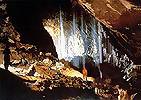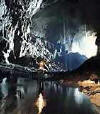|
 Gua
Tempurung
in Gopeng, Perak about 25 km south of Ipoh, an old bandit hideout
in more recent days, conceals an intricate system of caves
honeycombed inside the limestone hills. Explore a Gua
Tempurung
in Gopeng, Perak about 25 km south of Ipoh, an old bandit hideout
in more recent days, conceals an intricate system of caves
honeycombed inside the limestone hills. Explore a
gallery of stalagmites and stalactites and other amazing rock
formations which are superb geological wonders. In the middle of
this cave there is a stalagmite over 2 million years old. The
"Giant", as the stalagmite is called, points high into the cave,
and even the ceiling of the cave is majestic. Shine your
flashlight into the underground river and enjoy the brilliant
reflections like stars in the night sky. Become transfixed as if
transported to some other place in the universe.
Mulu Caves
in Sarawak is honeycombed by the world's most extensive cave
system. 310 kilometres of passages have been surveyed and that is
only a third of what is believed to exist. The system includes the
world's largest natural chamber, Sarawak Chamber at 600 metres
long, 450 metres wide and 100 metres high, is capable of holding
London's St. Paul's Cathedral, the world's largest cave passage,
Deer Cave, and the longest cave in Southeast Asia, Clearwater
Cave, which runs for 108 kilometres and has never been traversed
from end to end. Most visitors go to Deer Cave at sunset to watch
a black river of three million bats pour out on their nightly
forage for insects.
The Caves of Fairies & Winds
are about 8 KM from Bau town, located on the Mount Kapur in
Sarawak. The entrance of the cave is about 36 meters above the
base of the cliff. A concrete staircase of
over 100 steps will lead you to the entrance of the cave. The
beautiful view that you can see, up from the entrance of the Cave
of Fairies of the valley below, with its forest and fields is a
wonderful relief after the climb. From the entrance, a wooden
staircase will lead you to the

Chambers of the Caves of Fairies. Don't hold your breath when you
see the extremely human like stalagmites and stalactites, or feel
the presence of fairies! Nearby is the Wind Cave where
stairs and plank walks lead to the main cave and two underground
tunnels. A continuous breeze surge through the tunnels, giving the
cave its name.
|
